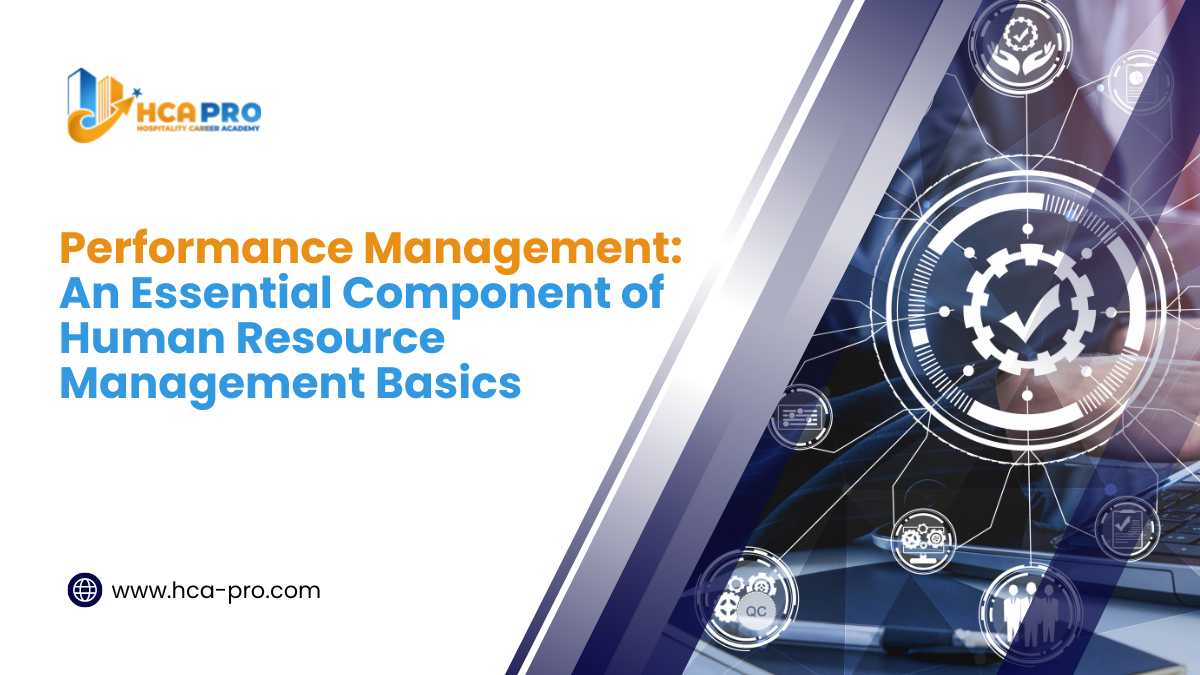
Introduction to Performance Management: Overview of the concept and its importance to human resource management.
The concept of performance management is essential for any organization to maximize the potential of its human resources. Performance management is a systematic process for setting expectations, measuring performance, providing feedback, and rewarding successful performance. As one of the seven human resource management basics, it is important to understand the components of performance management and how they contribute to organizational success.
Goals and Objectives of Performance Management
Performance management is all about setting expectations and creating measurable goals for employees. The goals should be SMART (specific, measurable, achievable, relevant, and time-bound) and should be based on the organization's overall objectives. It is also important to ensure that employees understand these goals and what is expected of them.
Some specific objectives of performance management may include:
-
Improving individual and organizational performance: By setting clear goals and providing feedback and coaching, performance management can help employees improve their job performance and contribute to the overall success of the organization.
-
Facilitating career development: Performance management can provide employees with development opportunities and help them identify areas for improvement that can support their career advancement.
-
Increasing employee engagement and motivation: By recognizing and rewarding good performance, organizations can increase employee engagement and motivation.
-
Enhancing communication and collaboration: Performance management can facilitate open and honest communication between managers and employees, which can improve collaboration and teamwork.
-
Improving decision-making: By gathering and analyzing data on employee performance, organizations can make informed decisions about talent management and resource allocation.
-
Aligning individual performance with organizational goals: By ensuring that individual employee performance is aligned with the overall goals of the organization, performance management can help to increase productivity and drive business results.
Designing Performance Management Systems
A comprehensive performance management system should include elements such as goal setting, performance measurement, feedback, and rewards. The system should also be tailored to meet the organization's specific needs and objectives.
There are several steps that organizations can follow when designing a performance management system:
-
Define the purpose and goals of the performance management system: It is important to clearly articulate why the organization is implementing a performance management system and what it hopes to achieve.
-
Identify key performance indicators (KPIs): Determine the specific metrics that will be used to measure employee performance. These should be aligned with the organization's goals and the expectations of each role.
-
Communicate the performance management process: Make sure that all employees understand how the performance management system works and what is expected of them.
-
Set clear and measurable goals: Goals should be specific, achievable, relevant, and time-bound.
-
Provide ongoing feedback and coaching: Employees should receive regular feedback on their performance, both positive and constructive, to help them understand how they are doing and how to improve.
-
Conduct performance evaluations: Periodic evaluations provide an opportunity for employees to discuss their job performance with their supervisor and identify areas for improvement.
-
Manage performance problems: If an employee is not meeting the expectations of their role, it is important to address the issue in a timely and constructive manner.
-
Recognize and reward good performance: Rewarding good performance, whether through praise, recognition, or incentives, can help to motivate and engage employees.
-
Align performance with organizational goals: Ensuring that individual employee performance is aligned with the overall goals of the organization can help to increase productivity and drive business results.
Implementing Performance Management
Implementing a performance management system is no easy task and requires careful planning and consideration. It is important to ensure that the system is properly communicated and understood by all employees and that it aligns with the organization's goals and objectives.
There are several key steps to implementing a performance management system in an organization:
-
Plan and design the system: Determine the purpose and goals of the performance management system, identify key performance indicators (KPIs), and develop a plan for how the system will be implemented.
-
Communicate the process: Make sure that all employees understand how the performance management system works and what is expected of them. This can be done through training sessions, informational meetings, or written materials.
-
Set clear and measurable goals: Goals should be specific, achievable, relevant, and time-bound. Employees should be involved in setting their own goals to ensure that they are motivated and engaged.
-
Provide ongoing feedback and coaching: Employees should receive regular feedback on their performance, both positive and constructive, to help them understand how they are doing and how to improve.
-
Conduct performance evaluations: Periodic evaluations provide an opportunity for employees to discuss their job performance with their supervisor and identify areas for improvement.
-
Manage performance problems: If an employee is not meeting the expectations of their role, it is important to address the issue in a timely and constructive manner.
-
Recognize and reward good performance: Rewarding good performance, whether through praise, recognition, or incentives, can help to motivate and engage employees.
-
Align performance with organizational goals: Ensuring that individual employee performance is aligned with the overall goals of the organization can help to increase productivity and drive business results.
Evaluating Performance
Performance can be evaluated in a number of ways, depending on the organization's specific needs. Metrics such as productivity, quality, customer satisfaction, and efficiency can be used to assess performance. It is also important to measure employee performance against the goals that were set.
Evaluating performance is an important aspect of performance management. It involves collecting and analyzing data on employee job performance, and using that information to determine how well employees are meeting the expectations of their roles and contributing to the organization's goals.
There are several methods that organizations can use to evaluate employee performance:
-
Self-assessment: Employees can assess their own performance by completing a self-evaluation form or writing a self-assessment report.
-
Supervisor evaluation: Supervisors can evaluate employee performance based on their observations and interactions with the employee.
-
Peer evaluation: Colleagues can provide feedback on an employee's performance through a peer evaluation process.
-
Customer evaluation: Customers or clients can provide feedback on an employee's performance through surveys or other evaluation methods.
-
Results-based evaluation: Employee performance can be evaluated based on the results they achieve, such as meeting sales targets or completing projects on time.
Regardless of the method used, it is important to provide employees with clear and objective feedback on their performance, and to involve them in the evaluation process to ensure that it is fair and accurate.
Providing Feedback
Providing timely and effective feedback is essential for successful performance management. Feedback should be constructive and focus on areas of improvement. It is also important to provide recognition for successful performance.
Providing feedback is an important aspect of performance management, as it helps employees understand how they are doing and how to improve. Effective feedback should be specific, timely, and focused on the employee's performance, rather than their personality.
Here are some tips for providing effective feedback:
-
Be timely: Provide feedback as soon as possible after the event or behavior in question. This will help the employee to understand the context and make the necessary changes.
-
Be specific: Be clear and specific about what the employee did well or what needs improvement. Avoid vague or general comments.
-
Focus on the behavior, not the person: Feedback should be focused on the employee's performance, rather than their personality or character.
-
Use examples: Provide specific examples to illustrate your points and help the employee understand what you are referring to.
-
Be objective: Avoid letting personal feelings or biases influence the feedback you provide. Stick to the facts and focus on the employee's performance.
-
Use "I" statements: Use "I" statements to express your own observations and feelings, rather than blaming or accusing the employee.
-
Offer suggestions for improvement: In addition to pointing out areas for improvement, provide suggestions for how the employee can improve their performance.
-
Be open to feedback: Encourage the employee to provide their own feedback and be open to their perspective.
Rewarding Performance
Differentiating rewards for successful performance is an important part of performance management. Rewards can include financial or non-financial incentives, such as recognition, promotions, or additional benefits.
Rewarding good performance is an important aspect of performance management. By recognizing and rewarding employees for their contributions, organizations can increase employee motivation and engagement, and improve overall performance.
There are many ways that organizations can reward performance, including:
-
Praise and recognition: Verbal praise, a thank-you note, or recognition at a team meeting can go a long way in recognizing and rewarding good performance.
-
Incentives: Offering financial or non-financial incentives, such as bonuses, gift cards, or additional time off, can provide a tangible reward for good performance.
-
Development opportunities: Offering employees the opportunity to attend training, conferences, or professional development courses can be a valuable reward that helps them improve their skills and advance their careers.
-
Promotion or advancement: Promoting or advancing an employee can be a meaningful way to reward good performance and recognize their contributions to the organization.
It is important to consider the needs and preferences of individual employees when deciding on a reward, and to recognize and reward good performance on an ongoing basis, rather than just during annual performance evaluations.
Conclusion
Performance management is an essential component of human resource management basics. It is a systematic process for setting expectations, measuring performance, providing feedback, and rewarding successful performance. Understanding the components of performance management and how they contribute to organizational success is key to maximizing the potential of an organization’s human resources.
Read more: 6 Steps for Recruitment & Selection
